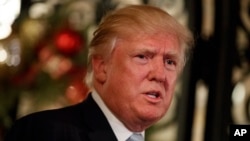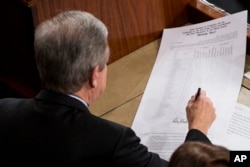Members of the U.S. Congress have officially counted Electoral College votes and verified Donald Trump's election as the 45th U.S. president.
The electoral vote count is the final step in legitimizing the results of the national vote held on November 8, 2016. It is the responsibility of the vice president to certify the vote of the Electoral College, which meant Vice President Joe Biden presided over Friday's joint session of Congress.
During the vote count, Democratic members of the House of Representatives objected to votes reported from at least 10 states, because of complaints about voter suppression and the belief that Russia used online influence to tamper with election results.
Federal law mandates that an objection must be supported by a member of the other house of Congress in order to be discussed. When House members raised objections, senators stayed quiet, so in each case Biden was obliged to respond by saying, "There can be no debate."
Republicans boo Democrat's objection
Toward the end of the count, Representative Maxine Waters, an African-American member of the Democratic Party from California, pleaded for at least one senator to stand up in support of her objection. In answer, Republicans booed.
Protesters also attended the joint session, in the public seating area. Several were ejected when their behavior become disruptive.
The final electoral count was 304 votes for Trump and 227 for Democrat Hillary Clinton. Seven electors registered "protest votes" for other candidates. Biden made the formal announcement declaring Trump the winner after the count was complete.
Critics of the U.S. Electoral College noted that this was the second time in less than two decades that a Democrat won the larger share of the popular vote but lost to a Republican who won a greater number of Electoral College votes.
In 2016, Clinton got nearly 3 million more popular votes than Trump, but lost the overall election because the Republican candidate won in enough states to guarantee him a majority in the Electoral College, which has 538 members.
In 2000, Democrat Al Gore won the popular vote by a narrower margin, but lost the Electoral College vote to Republican George W. Bush after a prolonged recount in Florida and a series of court challenges. The case ultimately went to the Supreme Court, which halted the Florida recount on a 5-4 ruling that effectively made Bush the 43rd president, just six days before the Electoral College met in mid-December.
Electoral College history
The Electoral College system of voting, enshrined in the U.S. Constitution, tends to favor the interests of less populous U.S. states. The size of the college is based on the size of each state's congressional delegation. Every state has two senators, accounting for 100 Electoral College members. To that is added a number of electors equal to each state's seats in the House of Representatives — 435 in all, ranging from one seat for the smallest states to 53 for the largest, California. With the addition of three electors from the District of Columbia, which is not a state but is home to the nation's capital, the total size of the college rises to 538 members.
Caroline Frederickson of the American Constitution Society for Law and Policy told VOA the system could be changed either by amending the Constitution — a difficult and complicated procedure — or alternatively, if enough U.S. states band together to award their electoral votes to to the candidate who wins the popular vote nationwide.
At present, 10 U.S. states plus the District of Columbia, representing 165 electoral votes, have agreed to pledge their electors to the winner of the nationwide popular vote, but their plan would not take effect until more states have enlisted — enough to command at least 270 votes, the majority necessary to guarantee a presidential victory. Even if that threshold is reached, however, other legal challenges could be expected on constitutional grounds.
House member Sheila Jackson Lee of Houston, Texas, said the 2016 election contained "absolute violations and absolute failures," including local authorities' "suppression" of some votes, and alleged Russian interference in U.S. politics. She had wanted Congress to debate those issues, she said, and she does not plan to drop the issue.
Speaking to VOA after the Electoral College vote was counted and certified Friday, Lee said she and her allies respect the college as an institution, but she vowed, "We're not going to let the enormous amount of voter suppression that occurred go silently into the night."
Trump and his vice president-elect, Mike Pence, will be sworn into office on January 20.
VOA's Katherine Gypson and Marissa Melton contributed to this report.





























